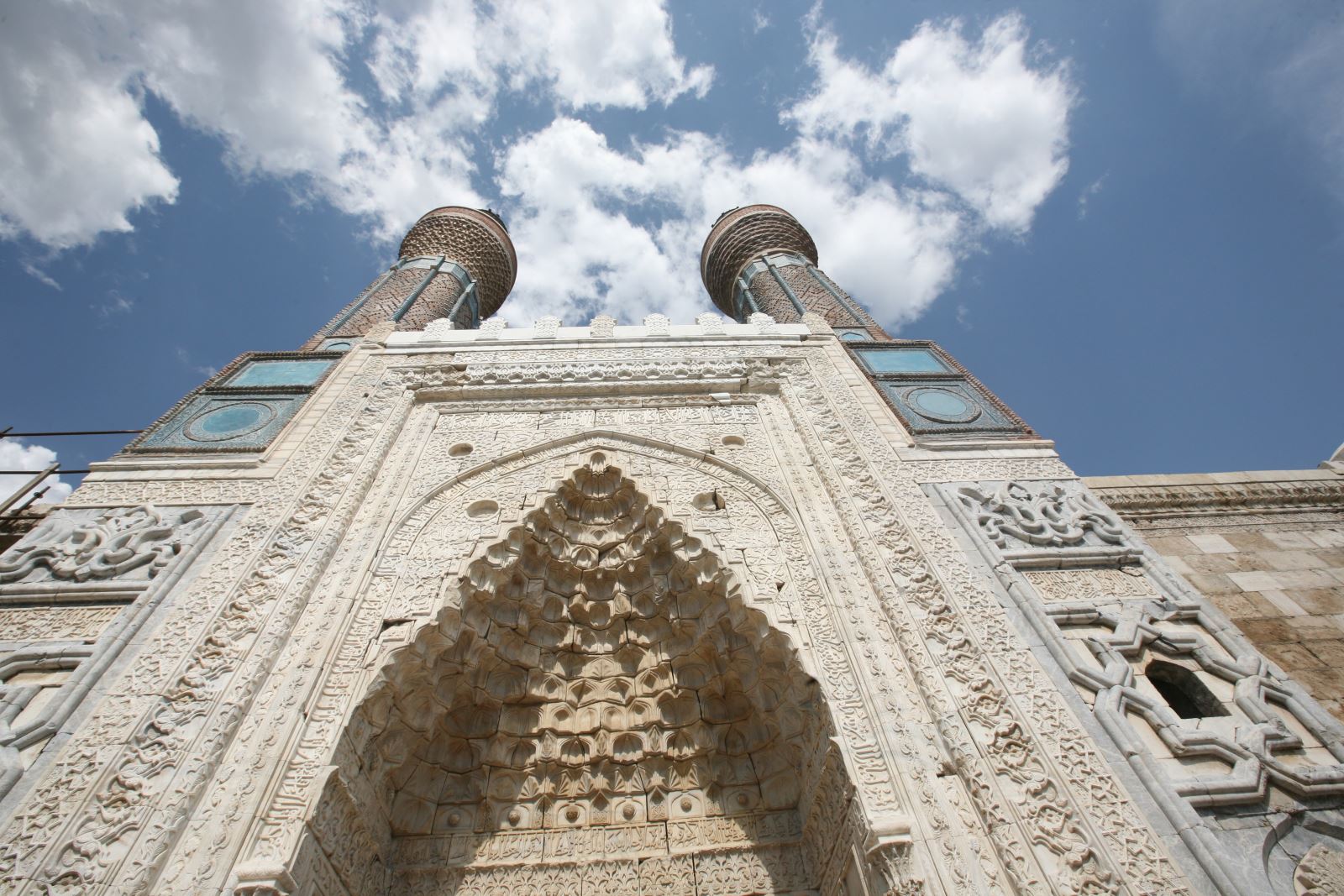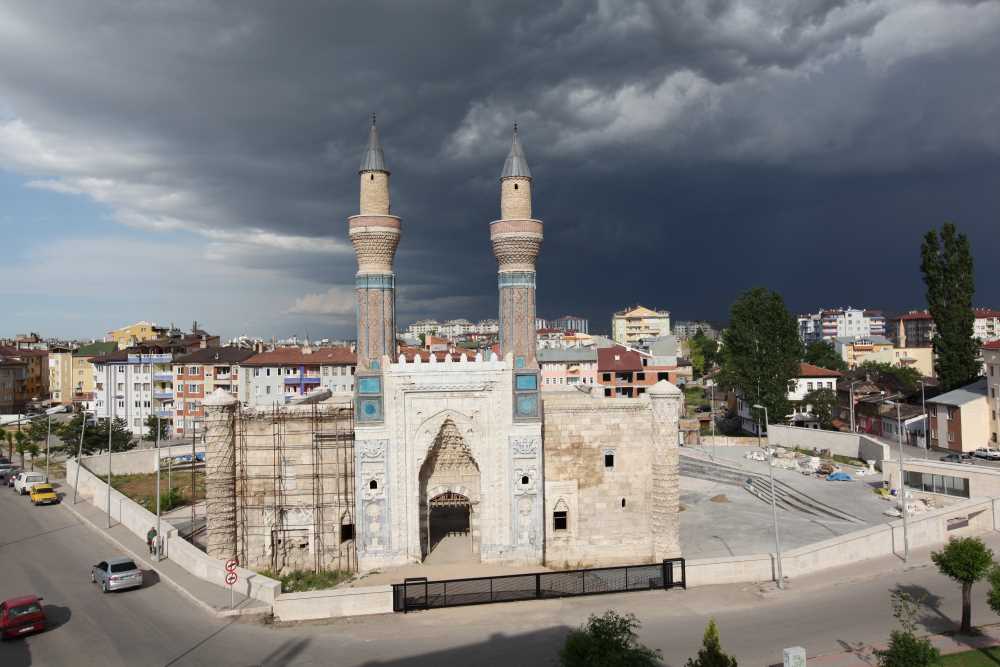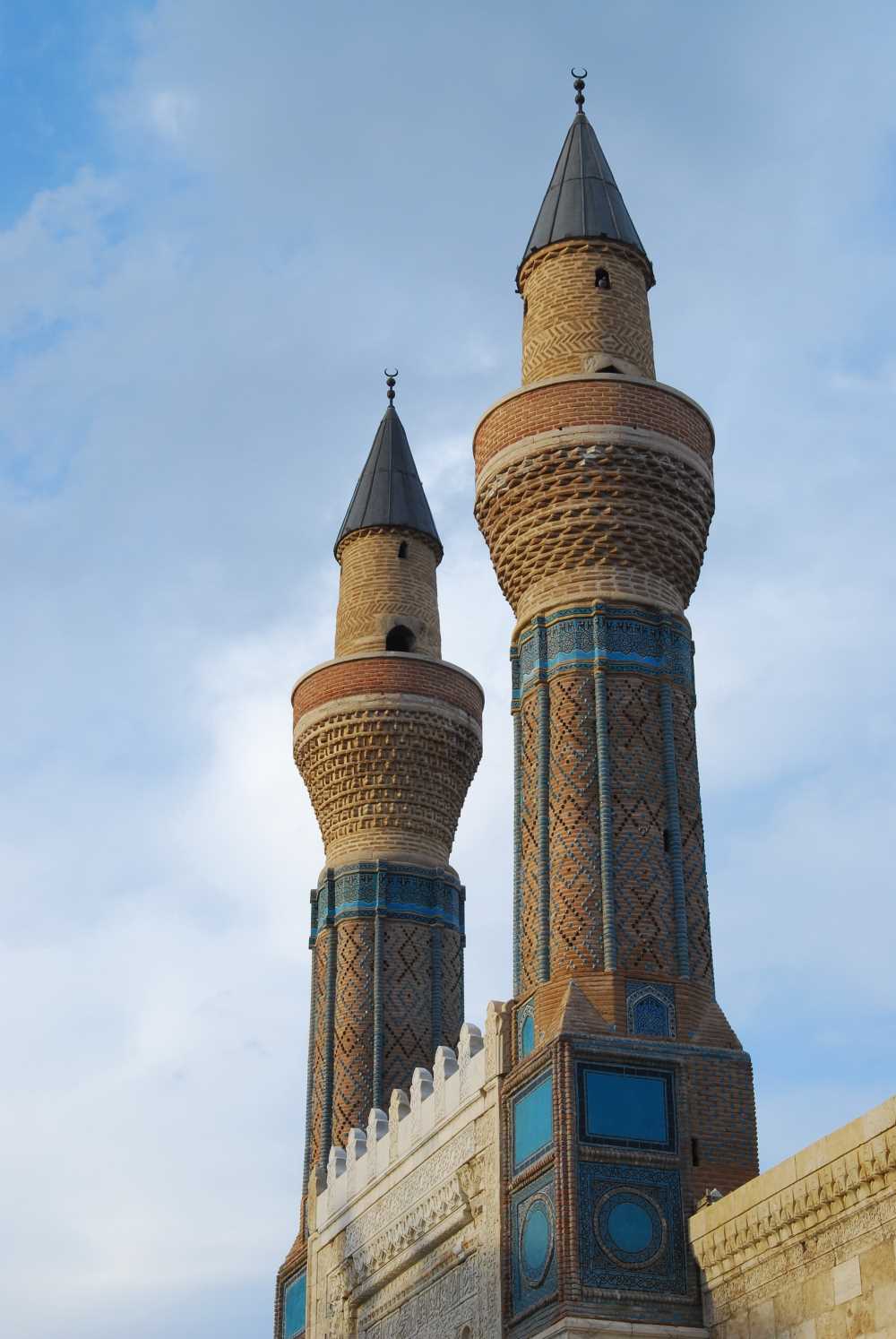Gök Medrese, one of the finest examples of Anatolian Seljuk architecture, was built in 1271 in Sivas. The structure harmoniously blends architecture and decorative arts, featuring turquoise-colored tiles, a monumental marble portal (taç kapı), a double-minaret façade design, and intricate ornamentation. It was commissioned by Vizier Sahip Ata Fahreddin Ali during the reign of Sultan Gıyaseddin Keyhusrev III. The madrasa served as a religious educational institution for many years and is currently undergoing restoration.

Gök Medrese (Türkiye Kültür Portalı)
History
According to inscriptions found in various parts of the building, Gök Medrese was built in 1271 during the reign of Sultan Gıyaseddin Keyhusrev III of the Anatolian Seljuk Empire by Vizier Sahip Ata Fahreddin Ali. The traveler Evliya Çelebi referred to the structure as the “Red Madrasa.” It is one of the three prominent Seljuk madrasas in Sivas. The main iwan on the eastern side collapsed and was later reconstructed in wood by Müftü Seyyid Abdullah Efendi. In 1926, it was converted into the Sivas Museum, served as a museum until 1967, and was later used for a period as an imam-hatip school.
Architectural Plan and Features
Gök Medrese has an open courtyard, two stories, and a four-iwan layout. The courtyard, measuring 24.25 x 14.50 meters, is flanked by arcades on two sides. Behind the seven-arched arcades are lateral iwans and three barrel-vaulted cells on each side. The entrance iwan is covered with a star vault. The right door leads to the masjid, and the left door to the darülkurra (Quranic recitation school). Access to the minarets is provided through these units. The masjid, square in plan (5.20 x 5.20 m), is topped by a dome that sits on a hexadecagonal drum, transitioned with Turkish triangles.

Gök Medrese (Türkiye Kültür Portalı)
Portal and Façade Design
The façade of the madrasa spans 31.25 meters, distinguished by a monumental portal measuring 4 x 7 meters, which protrudes 1.80 meters from the façade. Together with the two flanking minarets, the structure reaches a height of 25 meters. The shafts of the minarets are decorated with large rhombuses and octagonal stars. To the right of the portal is a three-spout fountain adorned with geometric borders. The portal itself is framed on three sides by vegetal and geometric motifs beyond the outer bands. The muqarnas niche contains 14 tiers, resembling a honeycomb. The upper corners of the portal display intricate leaf carvings with animal heads.
Tree of Life and Figurative Decorations
The animal-figure reliefs located beneath the minarets and the portal reference the Twelve-Animal Turkic Calendar. The Tree of Life motif, along with eagles, birds, and pomegranates, is symmetrically featured beneath both minarets. This arrangement is a unique example of figurative ornamentation in Anatolian Seljuk art.
Materials, Techniques, and Ornamentation
The ground level uses marble and limestone, while brick is used in the upper parts of the minarets. The marble used in the portal creates depth through light and shadow play. Glazed bricks and mosaic tile decorations are prominent in the minarets and the mihrab of the masjid. The mihrab’s surroundings are adorned with dark blue, purple, and turquoise tiles, inscribed with verses in a floral Kufic style. Notably, Ayat al-Kursi is inscribed in Kufic script on a turquoise background.
Architect: Kaluyan al-Konevi
The architect of the madrasa was Kaluyan al-Konevi. Although not mentioned in the endowment deed, his name appears on one of the corner panels. Originally a Christian, Kaluyan reportedly converted to Islam after meeting Mevlana Jalal al-Din Rumi, becoming one of his followers. He studied under Kelük bin Abdullah and worked on various buildings for Sahip Ata, achieving mastery in architecture and decorative arts, particularly evident in Gök Medrese. He is believed to have passed away in the 1290s.
Endowment and Educational Structure
The original endowment deed (vakfiye) of Gök Medrese has survived and reveals it was an educational institution focused on Islamic law (fiqh). According to the deed, the head instructor (mudarris) was preferably from the Shafi‘i school; if unavailable, a Hanafi instructor was temporarily appointed. Education was open to all students, regardless of sect. The madrasa's income sources included: 85 shops, 2 caravanserais, 2 baths, 5 private houses, 1 workshop, 30 cells, 18 homes, 1 oil mill, 2 properties, 4 gardens, 12 plots of land, and 9 villages.
Artistic Value and Decoration
The stone, brick, and tile decorations of Gök Medrese exemplify the richness of Anatolian Seljuk tile art. The minarets, similar in style to those of the Ince Minaret Madrasa in Konya and the Çifte Minareli Madrasa in Erzurum, are notable for their tile and brick ornamentation. The tilework on the rear wall of the iwan continues the tradition seen in Harraqan tombs of the Great Seljuks.
Preservation
Gök Medrese was officially registered on July 8, 1977 by decision A-646. Today, it is under the authority of the General Directorate of Foundations of Turkey and is undergoing a comprehensive restoration. It was previously restored in 1824 and 1904, with the minaret balconies being repaired in the 1940s. With significant budget allocations for education and administrative staff, it was considered one of the leading madrasas of its time.

Gök Medrese (Türkiye Kültür Portalı)


